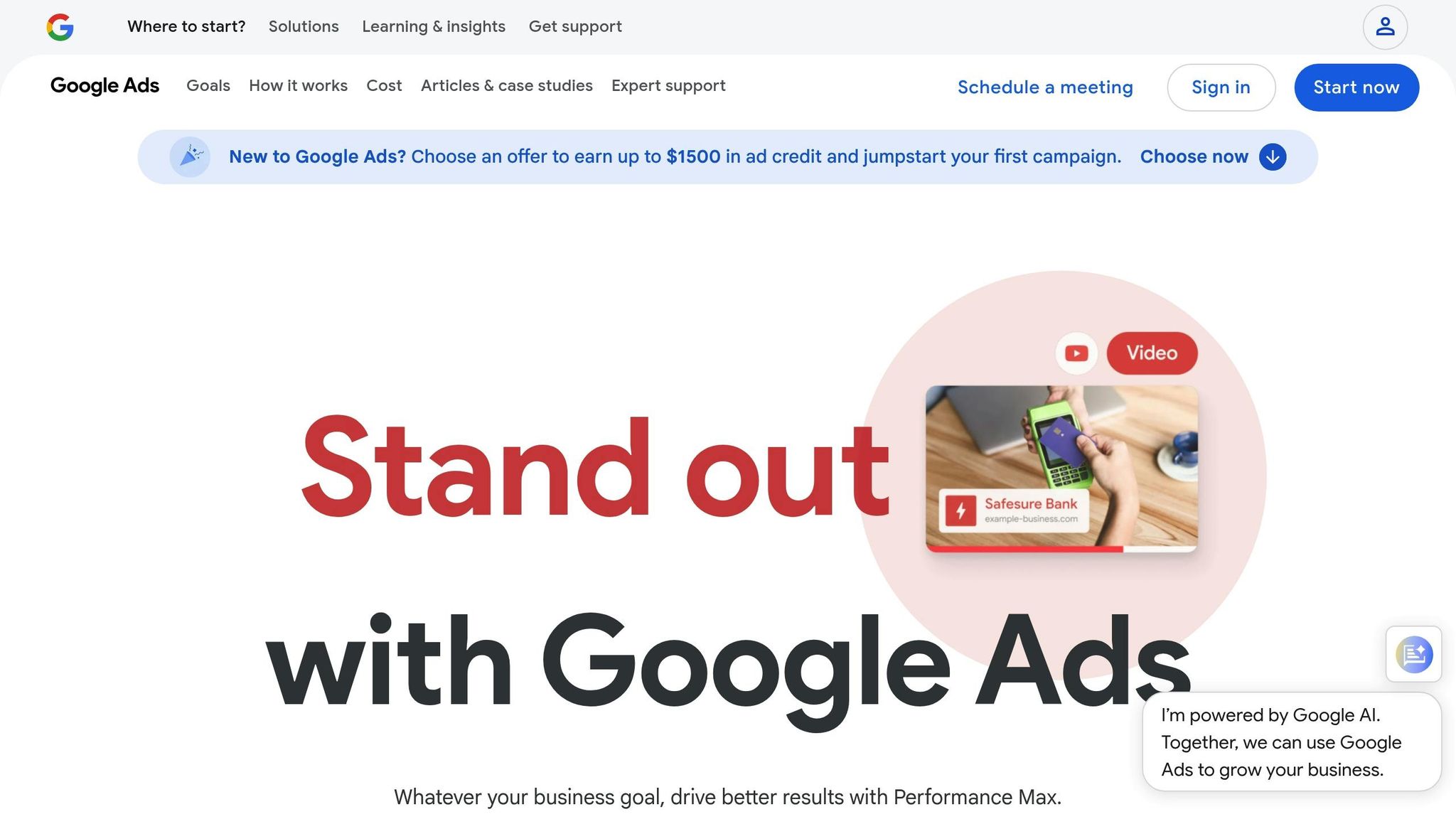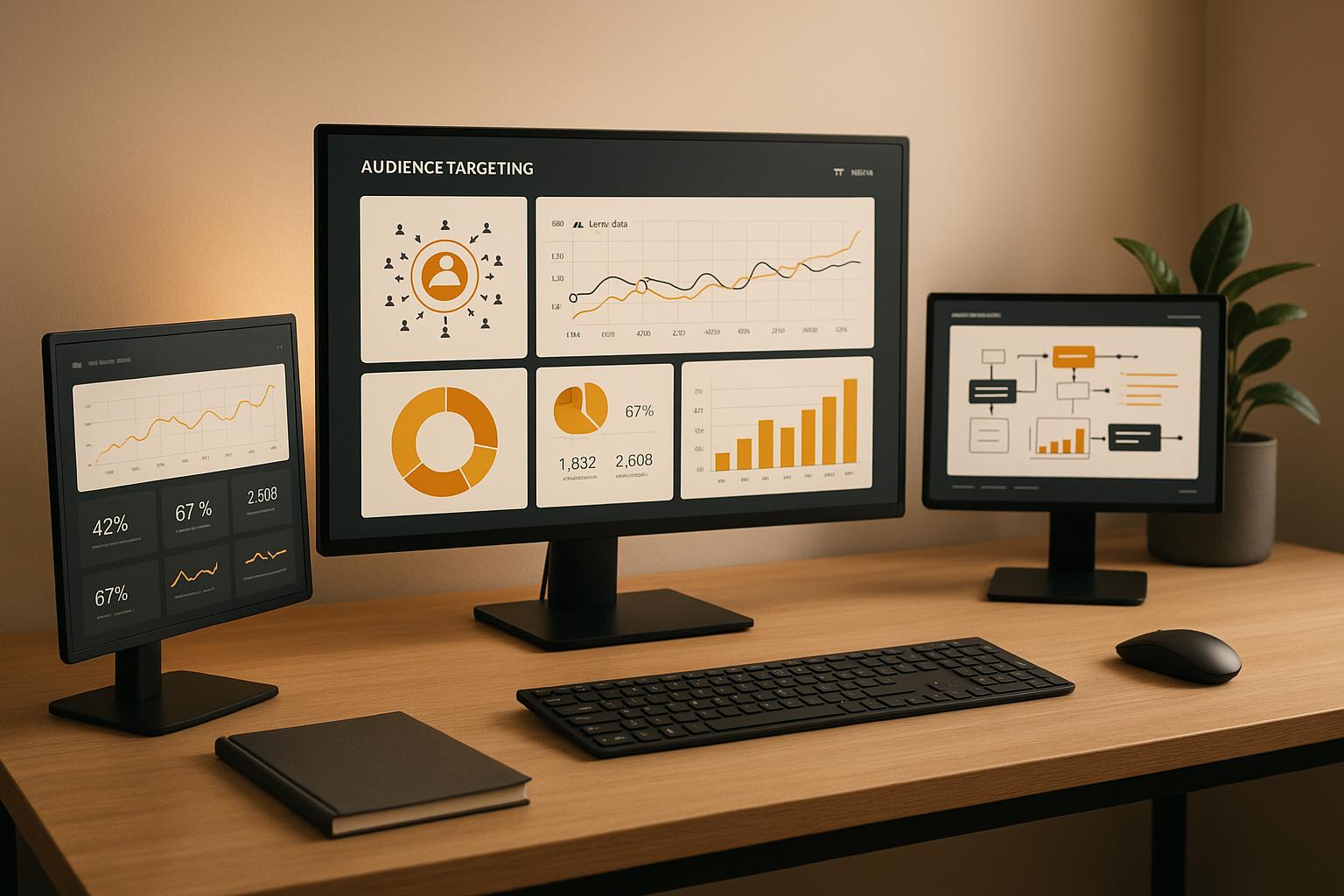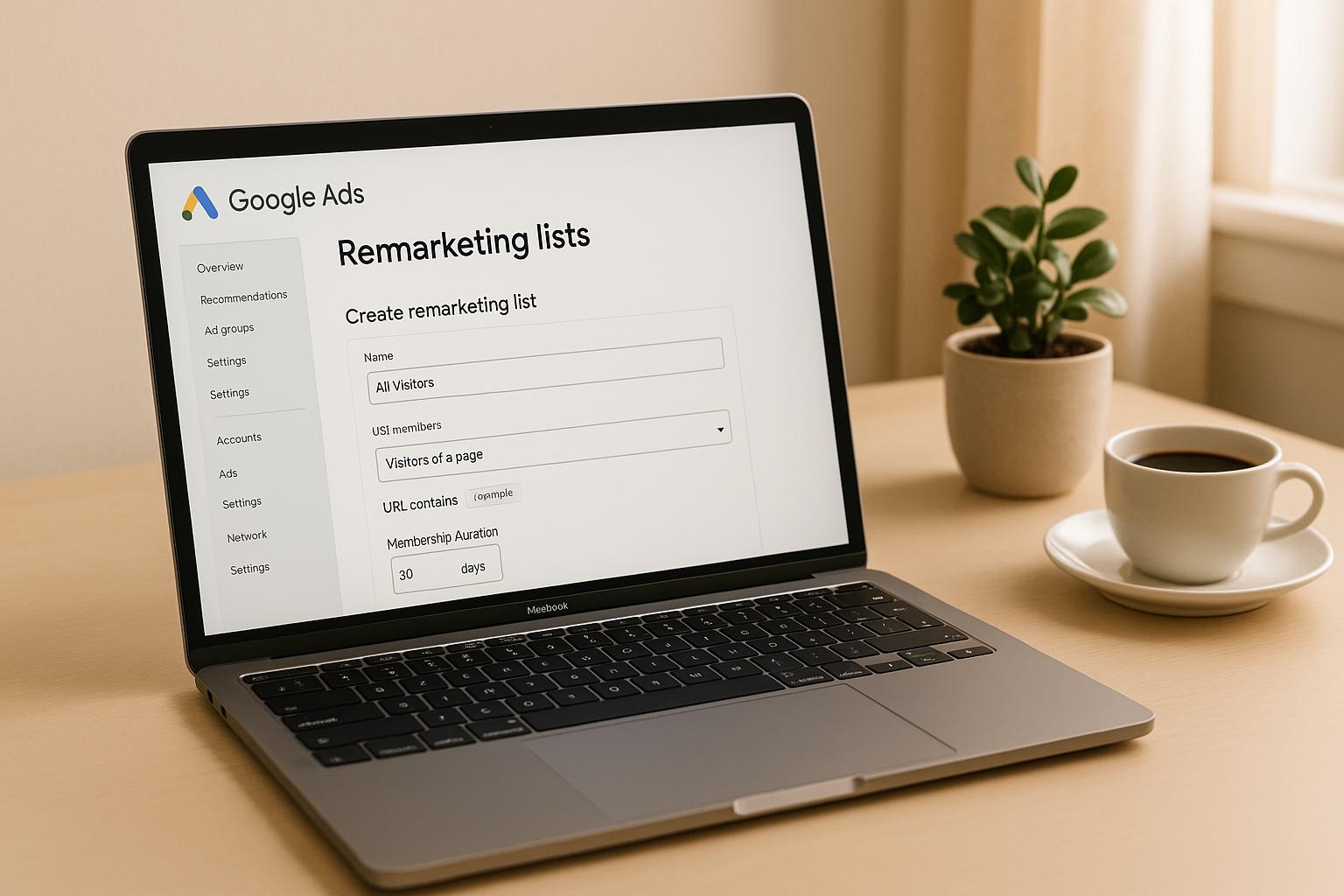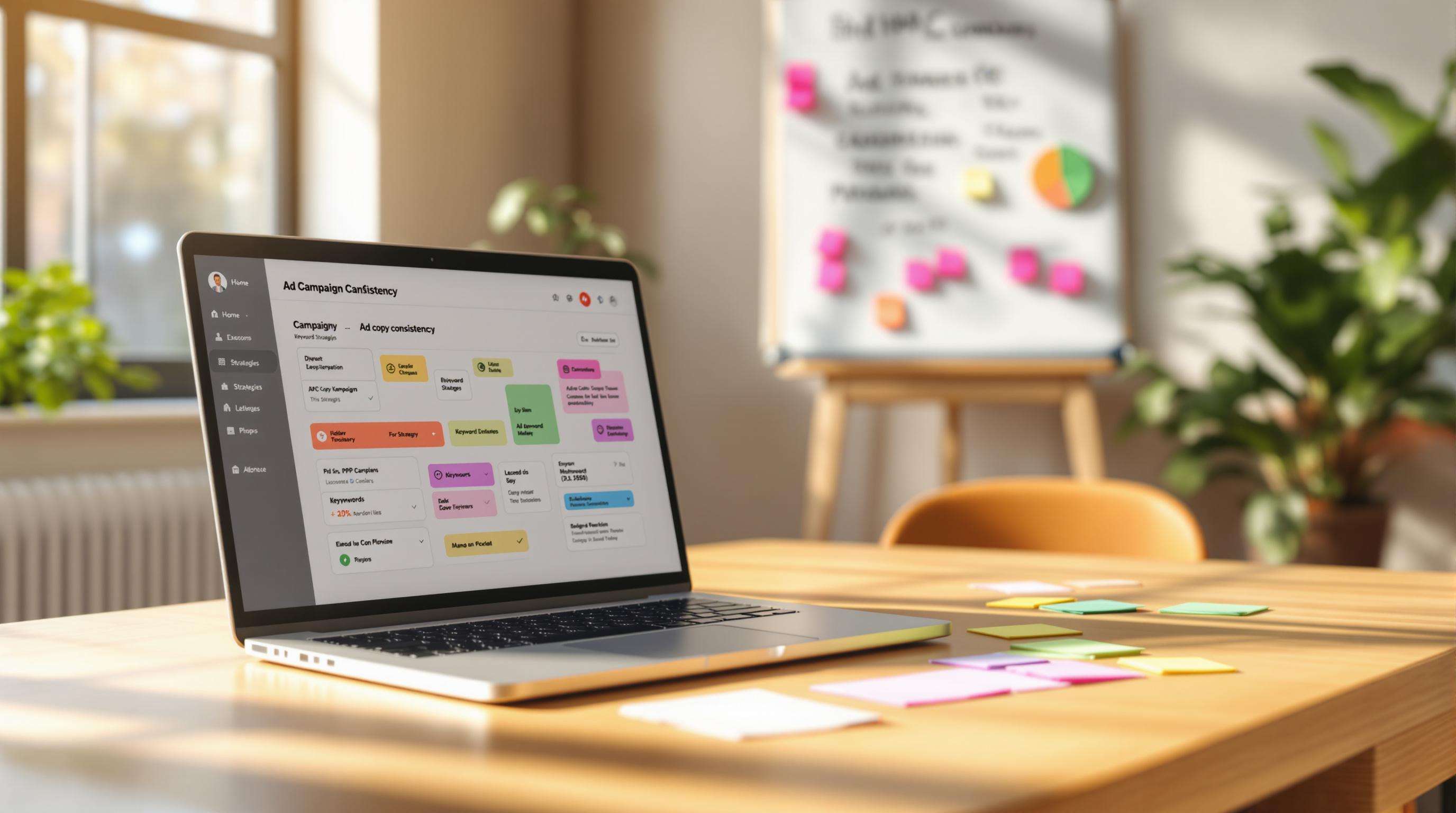Real-time bid optimization is an automated strategy that uses machine learning to adjust ad bids dynamically based on live user data. This approach evaluates factors like location, device, and conversion potential within milliseconds to maximize ad performance and minimize wasteful spending. Here's what you need to know:
- How It Works: Algorithms analyze user behavior, predict conversion likelihood, and adjust bids in real time.
- Key Benefits: Increases conversions, reduces costs, and simplifies PPC campaign management.
- Main Tools: Platforms like Google Ads offer strategies like Target CPA, Target ROAS, and Maximize Conversions.
- Why It Matters in the U.S.: U.S. consumers' multi-device habits, regional spending patterns, and competitive industries make precision bidding essential.
Key Strategies
- Automated Bidding: Uses algorithms to optimize bids for goals like cost per acquisition or return on ad spend.
- Data-Driven Adjustments: Fine-tunes bids based on devices, locations, time of day, and audience behavior.
- Prerequisites: Accurate conversion tracking, sufficient historical data, and well-structured campaigns.
Case Studies
- A Texas B2B software company reduced costs and improved lead quality by combining Target CPA bidding with device and time-of-day adjustments.
- A home services provider boosted conversion rates by aligning bids with high-performing regions and customizing landing pages.
Takeaway: Success hinges on using reliable data, choosing the right bidding strategies, and continuously monitoring performance. U.S. advertisers, in particular, benefit from this approach due to the market's complexity and competitiveness.
Set the RIGHT Bidding Strategies for Google Ads [with real examples]

Main Strategies for Real-Time Bid Optimization
Achieving success in real-time bid optimization hinges on three key strategies that work together to boost campaign performance. These strategies focus on improving decision-making, interpreting data effectively, and structuring campaigns for maximum impact.
Automated Bidding Algorithms
Modern platforms rely on machine learning to handle real-time bid optimization. These algorithms analyze thousands of signals at once, making instant bidding decisions that would be impossible for humans to replicate.
- Target CPA (Cost Per Acquisition): This method uses historical data to find high-conversion clicks while keeping costs under control. It’s particularly effective for lead generation campaigns with specific cost goals.
- Target ROAS (Return on Ad Spend): Designed for revenue-focused campaigns, this approach adjusts bids to prioritize high-value prospects while scaling back on lower-value opportunities - perfect for e-commerce.
- Maximize Conversions: The goal here is to drive as many conversions as possible within your daily budget. The system identifies the best bid for each auction to maximize conversion volume.
- Maximize Conversion Value: Instead of focusing on quantity, this strategy prioritizes the total value of conversions. It’s best suited for campaigns where tracking the value of each conversion is accurate and reliable.
These algorithms typically require 2-4 weeks to gather enough data to perform optimally. Once they’re running smoothly, you can enhance their effectiveness with precise, data-driven adjustments.
Data-Driven Bid Adjustments
To get the most out of automated bidding, combine it with targeted bid adjustments based on specific performance signals. This approach fine-tunes your strategy and helps improve return on investment.
- Device-based adjustments: People behave differently on smartphones, tablets, and desktops. Adjusting your bids based on device performance ensures you allocate more budget toward high-performing devices.
- Location targeting: For U.S. advertisers, geographic adjustments can help you focus on high-value markets while reducing spend in areas with lower potential.
- Time-of-day optimization: Consumer behavior often follows predictable patterns. Analyzing hourly performance data allows you to target the times when your audience is most likely to convert.
- Audience-based bidding: Use first-party data and platform signals to identify and prioritize high-value prospects. Audiences with prior engagement or similarities to your top customers often deliver better results.
A powerful strategy might combine these adjustments. For example, you could increase bids by 20% for mobile users in major cities during peak evening hours, while reducing bids for desktop traffic in underperforming regions during off-peak times.
Requirements for Effective Optimization
For these strategies to work seamlessly, a strong foundation is essential. These elements ensure that both automated algorithms and manual adjustments can respond quickly and effectively to market changes.
- Accurate conversion tracking: Proper tracking is critical. Use tracking codes, set clear conversion goals aligned with your business objectives, and regularly audit your setup for accuracy.
- Sufficient historical data: Machine learning algorithms need a solid base of data to identify patterns. Most platforms recommend at least 30 conversions in the past 30 days for optimal performance.
- Well-structured campaigns: Organized ad groups and tightly themed keywords provide clear signals for algorithms, helping them align bids with user intent.
- Regular performance monitoring: Keep an eye on trends, seasonal shifts, and external factors that might require adjustments. This includes monitoring changes in competition or market conditions.
- Budget consistency: Maintain a steady budget for 2-4 weeks to allow algorithms to gather reliable data. Frequent changes can disrupt their ability to optimize effectively.
Case Studies: Real-Time Bid Optimization Results
These examples highlight how real-time bid optimization has reshaped PPC performance for U.S. businesses. By implementing smarter strategies, these companies improved campaign efficiency and lead quality.
Case Study 1: Lowering Cost Per Conversion for a B2B Software Company
A Texas-based B2B software company was struggling with high conversion costs and low-quality leads in its PPC campaigns. To tackle these challenges, the marketing team took a fresh approach by adopting target CPA bidding paired with strategic bid adjustments. They restructured campaigns into focused ad groups, separating high-intent keywords from more generic ones.
Device bid adjustments helped reduce spending on low-conversion channels, while time-of-day optimizations directed more budget toward peak engagement hours. Additionally, audience-based bidding zeroed in on visitors who showed greater on-site engagement. This combination of tactics not only reduced costs but also improved the quality of leads. Another U.S. business applied similar refinements to achieve better conversion rates.
Case Study 2: Boosting Conversion Rates with Tailored Landing Pages
A home services provider operating in major Texas cities faced a different challenge: low conversion rates on their service request forms, despite strong traffic. The team implemented a two-pronged strategy to address this.
First, they used location-based bid adjustments to shift more budget toward high-performing markets, reducing spend in smaller, less effective regions. At the same time, they customized their landing pages by adding local contact details, testimonials, and service-specific information. Their bidding strategies were tailored to campaign goals, such as prioritizing immediate responses for emergency services while using target CPA bidding for routine maintenance inquiries. These efforts led to better conversion rates and improved overall campaign efficiency.
These case studies demonstrate how blending automated tools with thoughtful, context-specific adjustments can transform PPC campaigns. By aligning strategies with business goals and customer behaviors, advertisers can achieve stronger results in the U.S. market.
sbb-itb-89b8f36
Comparing Real-Time Bid Optimization Methods
Understanding the strengths and weaknesses of various bid optimization methods is essential for tailoring your campaigns and making the most of your ad budget. Each strategy shines in specific scenarios, and selecting the right one - or a combination - can lead to better results and more efficient spending. This comparison builds on earlier discussions about bidding strategies and provides clarity on when to use each approach for the best PPC performance.
Automated bidding strategies, like Target CPA and Target ROAS, rely on machine learning to adjust bids dynamically. These systems excel at processing large volumes of data in real time to make adjustments. However, they require a solid foundation of conversion data to perform well and may sometimes focus on quantity rather than quality.
Manual bid adjustments give advertisers full control over their bidding decisions. This approach is ideal for businesses facing unique market conditions or seasonal trends that automated systems might overlook. The downside? It’s labor-intensive and prone to human error.
Portfolio bidding strategies allow advertisers to optimize multiple campaigns at once by pooling data and reallocating budgets to meet overarching business objectives. This method works well for businesses with diverse product lines or services but demands careful setup and ongoing monitoring.
Strategy Comparison Table
| Strategy | Key Features | Pros | Cons | Best Use Cases |
|---|---|---|---|---|
| Target CPA Bidding | Uses machine learning to hit cost-per-acquisition targets | Reduces manual effort and adapts to market changes | Needs sufficient conversion data; may not maximize volume | Lead generation with clear conversion goals |
| Target ROAS Bidding | Adjusts bids to meet return on ad spend targets | Focuses on revenue growth and profitability | Requires accurate tracking; less suited for awareness | E-commerce with varied product margins |
| Manual Adjustments | Full control over individual keyword bids | Offers flexibility and transparency | Time-consuming and error-prone | Niche markets, seasonal businesses, or new product launches |
| Enhanced CPC | Combines manual control with automated adjustments | Balances control and automation | Needs regular monitoring; less aggressive than automation | Transitioning from manual to automated bidding |
| Portfolio Strategies | Optimizes budgets across multiple campaigns | Leverages shared insights for better allocation | Complex setup; troubleshooting can be difficult | Multi-product businesses or multi-brand organizations |
Selecting the right strategy depends on your business model, campaign goals, and the data available. For instance, service-based businesses might find Target CPA bidding effective, while retailers with diverse product lines could benefit more from Target ROAS bidding.
Some advertisers adopt a hybrid approach, using automated bidding for key campaigns while relying on manual adjustments for experimental ones. Regularly reviewing performance and adapting to market changes is essential to ensure long-term success. By integrating these insights with prior case studies, you can make informed decisions about the most effective bid optimization method for your needs.
Using Top PPC Marketing Directory for Optimization Success

The right tools and expert guidance can revolutionize how you handle real-time bid optimization in your PPC campaigns. The Top PPC Marketing Directory brings together a carefully vetted collection of PPC tools, agencies, and services designed to fine-tune bidding strategies and elevate campaign results.
This directory simplifies the often time-consuming process of researching PPC resources. By offering an organized listing of tools and services, marketers can skip the hassle of lengthy searches and focus on implementing real-time bid strategies that drive better outcomes.
Key Features of the Top PPC Marketing Directory
The directory categorizes PPC resources into distinct sections, each tailored to help you meet your optimization goals:
- Bid Management: Discover tools designed to improve bidding efficiency, from large-scale enterprise solutions to niche platforms specializing in dynamic bidding.
- Campaign Management: Access resources that streamline campaign oversight, ensuring your bidding strategies align seamlessly with broader marketing objectives.
- Performance Tracking: Find analytics tools that provide actionable insights, helping you monitor and refine campaign performance for better results.
- Expert Agencies: Explore profiles of agencies with proven expertise and success stories, making it easier to choose the right partner for your PPC strategies.
Advantages of Using Curated Resources
Relying on a curated resource like the Top PPC Marketing Directory can significantly reduce the trial-and-error process of finding the best tools and partners. Here’s how it helps:
- Matches tools to your budget and specific needs, optimizing your spending.
- Facilitates smarter decisions with detailed comparisons of features, pricing, and integration options.
- Keeps you up to date with the latest tools and innovations in the ever-changing PPC landscape.
- Allows side-by-side evaluations, so you can choose solutions that align with your current objectives and future growth plans.
Conclusion and Key Takeaways
Real-time bid optimization plays a crucial role in improving PPC performance for U.S. advertisers. Case studies consistently show that combining automated bidding with smart, data-driven adjustments can lead to lower costs and higher conversion rates.
But here's the thing: technology alone isn't enough. The most successful advertisers dedicate time to understanding their audience and align their bidding strategies with specific business goals. This thoughtful approach is what separates top performers from the rest.
At the heart of effective optimization is data quality. Without clean, reliable, and actionable data, even the most advanced algorithms can fall short. This highlights the need for solid tracking systems and accurate conversion data before diving into advanced bidding strategies. The success of any optimization method ultimately depends on the strength of your data foundation.
It’s also important to recognize that different strategies work best in different situations. Automated bidding thrives when you have plenty of data to work with, while manual adjustments are better suited for niche or newer campaigns where data may be limited.
To help you put these insights into action, the Top PPC Marketing Directory offers a curated selection of tools and services tailored for real-time bid optimization. From bid management platforms to performance tracking solutions and expert agencies, this directory can save you time by pointing you to the resources you need. Instead of spending weeks researching, you can focus on applying proven strategies that deliver measurable results.
Ultimately, success in real-time bid optimization comes down to three things: clear objectives, the right tools, and ongoing testing. It’s not a one-and-done effort - it’s a continuous process that rewards those who stay engaged and adaptable.
FAQs
How can businesses gather enough data for successful real-time bid optimization?
To achieve effective real-time bid optimization, businesses need to dive into their historical campaign data. This means keeping a close eye on key performance indicators, such as click-through rates (CTR), conversion rates, and cost-per-click (CPC) over time. By leveraging analytics tools and automated bidding platforms, you can break down this data, spot patterns, and make informed predictions that guide your bidding strategy.
It's also important to let campaigns run long enough to gather substantial data. The more information your system has to work with, the better it can fine-tune bids in real time, ultimately boosting your campaign's performance.
How can I effectively combine automated bidding with manual adjustments to improve PPC campaign performance?
To blend automated bidding with manual adjustments effectively, start by focusing on campaigns with a strong data foundation - ideally, those with at least 30 conversions in the last 30 days. This provides the automation algorithms with enough reliable data to make informed decisions.
A hybrid approach, like Enhanced CPC, is a great option. It lets you maintain manual control over bids while allowing automation to make real-time adjustments. This setup strikes a balance between human oversight and AI-driven optimization. Keep an eye on performance metrics and make small, thoughtful manual adjustments to ensure your bids align with your campaign goals. This method helps you maintain control while taking advantage of automation's strengths.
How does real-time bid optimization respond to market changes and consumer behavior, and what should advertisers focus on to stay effective?
Real-time bid optimization leverages advanced analytics and machine learning to fine-tune bids on the fly. By analyzing factors like audience behavior, market trends, and campaign performance, advertisers can adjust their bids to stay ahead in a constantly changing landscape.
For this approach to work effectively, keeping a close eye on key metrics is crucial. Metrics like conversion rates, engagement levels, competitor activity, and market trends provide valuable insights. By responding promptly to these data points, advertisers can refine their strategies and make the most of their ad spend.


